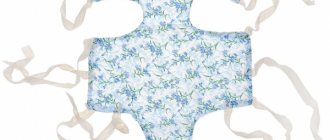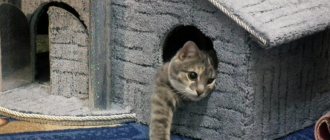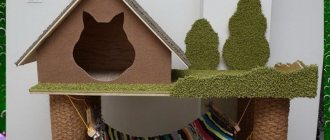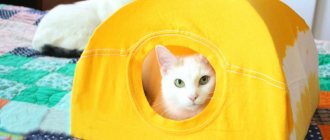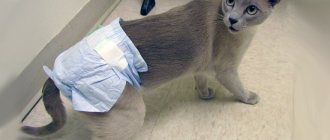A blanket is not the most necessary item in a pet's wardrobe, unless the animal belongs to breeds susceptible to the effects of cold, such as the Sphynx. It is more often used for hygienic purposes when the cat requires medical intervention in the abdominal area.
- 2 Types of blankets
- 3 How to choose a blanket for a cat
- 4 How to make a blanket for a cat with your own hands
4.1 Sock bandage
- 4.2 Fabric bandage
- 6.1 Video: veterinarian advice on caring for a cat after surgery
Types of blankets
There are the following types of this product:
- stylish blanket;
- protective;
- medical.
The first type of blanket is used to decorate the animal. A blanket has a practical function only in the case of sphinxes and other short-haired cats, whose sweat can stain things. It can also be useful in weaning kittens from breastfeeding.
Many owners enjoy the process of making beautiful clothes for their pet and displaying them.
A protective blanket is necessary for animals that are especially susceptible to the effects of cold, as well as for those cats that often go outside, for example, when kept in a country house. In this case, the blanket should be perceived simply as outer clothing and serve to prevent cooling.
The blanket in this case serves to insulate the animal.
Sometimes owners go further and, by analogy with clothing for dogs, use a blanket that protects from precipitation and dirt.
This blanket perfectly protects the cat from moisture.
The final type of blanket that we will consider is medical. Otherwise it is called a postoperative bandage. It serves to prevent infection and inflammation and solves the following problems:
- Dust. If it gets into the wound, infection may begin.
- Licking. Cats have a reflex that causes them to lick the painful area. But a rough tongue, along with bacteria on it, can only develop inflammation in the wound.
- Seam divergence. Even though after the operation the animal becomes less mobile and tries to take care of itself, but any careless movement, for example, washing, can cause the suture to come apart.
- Parasites. Liquid may be released from a fresh seam, which attracts insects that carry infections. To prevent this process, wipes are placed under the bandage to absorb the ichor.
Classic blanket, which is used after surgery according to doctor's indications
However, one should not assume that after abdominal surgery, the so-called abdominal surgery, the use of a bandage is mandatory. Before dressing an animal in a blanket, you must consult with the doctor who operated on it, and only after his consent proceed to purchase and putting it on.
Review of the standard medical blanket:
This blanket was developed in the Styopka community in 1997 with the goal of promoting the sterilization of cats as a primary remedy for their homelessness, and gradually became widely used.
The size of the blanket is universal, although, in my opinion, it is too big for our cat. Made of chintz, equipped with hebash ribbons.
You need to put on the blanket before the cat has fully recovered from the effects of anesthesia, otherwise you will find yourself bitten and scratched. The sequence of donning is clearly stated in the instructions for the blanket.
If desired, it is easy to provide access to the postoperative wound by untying several ribbons.
Of course, the blanket causes some inconvenience to the cat. Our beauty, for example, managed to chew off the braid at her thigh. However, the blanket reliably covers the post-operative wound, simultaneously giving the cat a comical appearance.
Abramych
https://otzovik.com/review_468406.html
And here the owner came up with the idea of adding a medical blanket with an ordinary nylon sock:
They brought it home and then it began - the cat, under anesthesia, did not know where to run or what to do. First of all, I chewed this diaper blanket on myself with my teeth! I started sewing it up with threads and, remembering my previous experience in sterilizing a cat, I immediately took a sock…. Yes, yes, an ordinary sock - a cut-off top from terry children's tights. I pulled the blanket over the cat’s sewn blanket and ran to the veterinary pharmacy for a new factory-made blanket.
But since it has ties and the cat can crawl somewhere and get caught, tights came to the rescue again! I pulled it over it (after cutting holes for the paws) and so my cat came out safely for all 14 days. I just bought 2 pieces - to replace them after washing. Instead of a terry sock, you can use a nylon stocking - for shaggy cats, so as not to be too hot. My little bald head is just right for her. And the ties won’t catch on the tummy support - that would tighten it a little. If you have to, put on a stocking right away - you’ll be calmer.
Misschiken
https://irecommend.ru/content/rekomendatsii-po-ispolzovaniyu-plyus-moi-khitrosti-foto
Dressing rules
Place the blanket on the pet, having first laid it on its side. Then they bring its edges together and tie the ribbons. The product should not be fixed too tightly. A properly worn bandage should fit snugly to the body and not sag or dangle. Strongly tightened ropes impair blood circulation at the dressing site, which increases the healing time of tissues. For greater reliability, the ribbons are secured to the paws and neck; their edges should be short.
They remove the blanket in the same way as they put it on. The cat is placed on its side, the fastenings are untied and the product is removed. Every day you need to allow the animal to walk for at least half an hour without a bandage, this will allow the seam to dry out faster. They finally get rid of the dressing material only on the day when the veterinarian allows it. This usually happens 8-9 days after surgery.
All owners of sterilized cats are faced with the fact that their pets take off their blankets. It will not be possible to constantly monitor the animal, so they resort to more stringent measures. At night, you can limit your cat's movements by placing her in a cramped crate or portable basket. She will not have the opportunity to run and twirl, so the blanket will remain in place.
Additionally, a surgical collar is put on the animal . Thanks to him, the cat will not be able to pull off the bandage with its teeth. If there is increased activity, the veterinarian may prescribe sedatives. They calm the pet and do not allow it to actively move.
But still, the main responsibility for the condition of the cat after sterilization lies with the owner. He needs to constantly stroke the animal and talk to it. This way, your pet will quickly get used to the blanket and stop trying to remove it.
How to choose a blanket for a cat
In order for the bandage to fit well on the animal, you need to pay attention to the following issues:
- Shop. Beware of unscrupulous sellers and do not buy goods second-hand. The blanket must be in individual transparent packaging, without opening or damage. Remember that this is a hygienic item, so the bandage must be steamed. You can buy blankets in pet stores with pharmacies or on the Internet.
- Material. The blanket should not stretch and cause allergies, so the best choice would be cotton fabric. The ties should be thick and strong.
- Color. It is better to choose a white and one-color bandage so that any wetness that may appear on the fabric is more visible. It is very important to inform your doctor in a timely manner about the presence of excess discharge from the wound.
- Size. Measure the girth of the cat's chest and the length of the back from the shoulder blades to the croup. These indicators affect the size. The bandage should not be loose or, on the contrary, tight; the animal should feel natural in it and not experience discomfort.
My cat was given a bandage at the veterinary clinic after surgery. The doctor himself selected the size and put a blanket on her. Therefore, in the process of preparing for sterilization, check with your doctor whether you need to buy the product yourself or whether a qualified specialist will do it for you.
If your pet is of an atypical size: too fat or thin, the best solution would be to make a blanket yourself rather than putting a bandage on it that will not fit perfectly.
Dressing up
The functionality and effectiveness of using a bandage for a cat during its postoperative period after sterilization depends not only on the correctness of its cut and manufacture. After surgery, the bandage must be tied correctly and carefully. If the fasteners or ties of the bandage are pulled too tightly, it will be too tight, and this will have a bad effect on the healing processes of stitches and wounds. A very loose tie is also ineffective; it will move, rubbing the seam on the animal, or the cat will pull it off altogether, and also damage the seams.
When dressing correctly, you need to unfold the bandage, straightening all the ties. Then the cat carefully lies down on it and the ties are secured in front near the head and front paws. After this, the back ties are tied in pairs above the paws and they are bandaged in the pelvic area. With different cuts of blankets, there may be a different order of dressing. The main thing after putting on the bandage is to make sure it is properly fixed. To do this, you need to let the cat move around the apartment. If she feels comfortable, moves around freely and does not try to tear off the bandage, then he is wearing it correctly.
It should be noted that there is no need to take off and put on the blanket every day. If you need to treat a seam after sterilization, or change a bandage, you can just untie a few ties. But still, we must take into account that during the period of wearing the blanket, which is 10-14 days, it may be necessary to change it to maintain cleanliness.
However, most cats feel uncomfortable wearing a bandage. They try to get rid of it, gnaw and tear it with their teeth and claws. Therefore, a properly selected fabric for a bandage, especially its upper part, should be relatively durable. If the cat nevertheless takes off the blanket, then first of all you need to inspect the seam and, if necessary, contact a veterinarian. If everything is fine with the seam, you need to carefully put the bandage back on so that it fits tighter.
Be more kind and gentle to your pets during this difficult period for them, pay them more attention and then they will forget about the bandage.
How to make a blanket for a cat with your own hands
There are several well-known ways to make a bandage at home.
Sock bandage
Take a sock that fits the size of the cat, maybe nylon, and cut out holes for the paws and tail. If the neckline is too long, shorten it. We make an incision on the back and several small holes, like on sneakers. We thread the lace through them crosswise. We try it on the animal and tighten it.
The advantage of this type of manufacturing is its speed, simplicity and low cost, and the disadvantage is the greater elasticity of the product and a possible allergic reaction to the composition of the fabric.
It is imperative to place a piece of cloth under a nylon sock to collect secretions.
Fabric bandage
Such a bandage will fit the cat much better due to its individual structure
In order to sew a fabric bandage at home, you must first measure the following parameters of the cat:
- the length of the pet from the base of the neck to the tail;
- from neck to shoulder blades;
- from croup to tail;
- neck girth;
- distance between the front paws;
- chest circumference;
- abdominal circumference at groin level.
Transfer the received data to the sheet, drawing the future product. It is necessary to make a small margin of 0.5–1 cm in length for future ties.
In the diagram, arrows indicate the measurement locations and the approximate length of the segments
Transfer the marks from the pattern onto the fabric. It is better to use two layers of material for greater strength. Using the resulting diagram, cut out the parts, fold in the allowances and sew on a machine, having previously overcast the edges of the product. Sew on the ties.
It is necessary to try the resulting product on your pet in order to make adjustments while there is still an opportunity. Pay attention to whether an additional tampon will fit in the area of your pet’s abdomen, as it may be needed as a result of the operation.
The advantage of this manufacturing option is the ability to tailor the product to the individual characteristics of the cat’s structure, and the disadvantage is that it is more complex in design, unlike the sock version, not to mention buying a ready-made one.
Several pattern options
Directly cutting out the blanket involves marking and cutting out holes for the paws on a piece of fabric, in strict accordance with the previously made measurements. Sometimes a pattern of a bandage or blanket is made in the form of a triangle with a hole for the tail at its top. The long sides of the triangle are wrapped around the cat's body along the front legs, and their ends, wrapped around the body, are taken out in front and tied in a knot behind the back. You can make a bandage after surgery with passages only for the front paws and distribute them evenly around the perimeter of the ties, Velcro or buttons. The buttons are very convenient to put on, but can easily come unfastened during use, therefore, they are not recommended.
You can cut out and sew a blanket by placing the cats' paws in small circles and the head in a larger circle. With this cutting, you need to cross the back and front ties. When tying it, you need to be careful not to pull the cat's fur along with the tie. When tying the bandage, you should also leave allowances for free movement of the diaphragm when breathing.
How to properly put a blanket on a cat
Before putting on the blanket, you need to freshen it in the washing machine without using powder and iron it on both sides. Introduce your cat to the bandage. After a welcome sniff, carefully put the product on her. Fasten the blanket tightly as shown in the figure:
It is better to tie a blanket while the animal is still under anesthesia.
Adjust the length of the ties so that the loose ends do not interfere with the animal. It is better to immediately cut off the excess so that the cat cannot accidentally get caught on something and injure itself during the owner’s absence.
Observe how the cat behaves. If wearing a blanket for the first time causes stress, remove the product from it and try putting it on again after a while. Don't expect a pet in a bandage to behave the same way as usual, because these freedom-loving animals do not like to have something put on them.
Unfortunately, before sterilizing my cat, I did not accustom her to the sensations of wearing a bandage, so when she woke up after anesthesia, she experienced additional discomfort due to the presence of an extra object on her body. And, having started to rise, she moved only in short dashes and mostly hovered with her paws bent. However, subsequently, after careful care, the movements became less intermittent, and in the end, the cat got used to it.
Purpose of the product
A blanket is placed over your pet's belly to protect the belly after surgery. Thanks to this cover, the surgical site is not affected by pathogenic microflora, and the animal will not be able to scratch and lick the wound. So the cat reflexively tries to speed up the healing process, but in reality this only leads to irritation. Along with her saliva, germs and viruses can enter the wound.
How to care for a cat after sterilization
Caring for a cat during the postoperative period is not limited to just purchasing or creating a blanket. It is necessary to provide your pet with increased attention, especially in the first hours after surgery. You need to pick up the animal from the clinic only in a carrier, having previously covered the bottom with a soft cloth or a special diaper.
Special technology allows the diapers to retain moisture inside for a long time and completely block odor
Carefully place the animal in the carrier, always on its right side, and cover it with something warm or place a heating pad or a bottle of hot water on its back. Do not neglect this, because after anesthesia, the cat’s body loses a lot of heat. Another feature of anesthesia is freezing of the eyes when open. To prevent the cornea from drying out, you need to open and close your eyelids every half hour or use special drops.
At home, leave the animal in the carrier or carefully, removing the edges of the diaper, transfer the cat to the floor. Keeping in mind your exposure to cold and drafts, choose a place close to the radiator, but under no circumstances place it close to the heater; excessive heat can cause bleeding. It is necessary to keep the cat under constant observation for 2–8 hours, waiting for it to wake up. During this time, you can massage your paws with gentle movements to improve blood circulation and speed up recovery from anesthesia. Remember that at the moment of awakening, the cat is capable of harming itself by making unconscious sudden movements or falling.
After the cat recovers from the anesthesia and begins to behave consciously, place a bowl of water and food in front of it. She may not touch the food, because her appetite does not return immediately, but you must definitely monitor it, because this is the main indicator of the animal’s health. It is better to introduce special food for operated animals.
Next, you just need to take care of the seam and observe the behavior of the animal. Check with the doctor who operated on the cat about what medications should be used to treat the wound. Under no circumstances should you engage in self-diagnosis and treatment; a cat’s body is different from a human’s and many medications may simply not be suitable.
The bandage should be worn for 3 days. It should be left only to those animals that are actively trying to lick the wound even through it.
Terms of use
We figured out how to sew the main parts of a medical blanket according to the pattern. However, it is equally important to know how to use such a device correctly.
After you have put the bandage on your cat, it is advisable to monitor your pet at least for the first time.
As a rule, your furry pet will not immediately like such a robe, so she will certainly try to take it off.
Additional recommendations include the following:
- If the cat’s wound is serious, a bandage layer under the bandage is a must. Thus, you will have to wash it less often, and the wound will not become infected, since you will be replacing the bandage;
- when the animal needs to relieve itself, you can untie two pairs of ribbons at the bottom of the blanket, and there is no need to remove it completely.
Take proper care of your pet, and the postoperative period will be less painful for him.
Recommended Posts
Standard height and weight of the Cane Corso breed by month
Weight of a puppy and an adult Labrador by month
Weight and height of a German Shepherd puppy by month
Description and content of the hunting border terrier
Description and care of the highly intelligent Border Collie breed
Description of forms and features of treatment of enteritis in cats
Pros and cons of clothing made from socks
Like any clothing, cat sweaters made from socks have a number of advantages and disadvantages. The main advantage is that the product is sewn quickly and easily. Even the lack of measurements is not a problem for creating such clothes. Another undoubted advantage is that everyone has warm terry socks, so in case of emergency it will not be difficult to get material for sewing. And, of course, another plus is the convenience and comfort of such a sweater for your pet.
As for the disadvantages, the main thing is the fragility of these clothes. But, considering that you can make clothes from a sock for a cat in just an hour, this drawback does not seem so significant. Another not-so-pleasant point is that such a jacket may not be suitable for large animals. In such cases, you can use your old sweater.
The main principles of sock sewing
Despite the very wide selection in stores, many owners prefer hand-made sewing, and there are a number of reasons for this.
First, you know what kind of fabric you are using. It is very important that it is natural to avoid allergies or irritation to the sensitive skin of the purr.
Secondly, sock cat clothes are quite simple. There are no elements in it that will hinder your pet’s movements or allow you to get confused in them. Do not forget that cats are playful and active animals, and tight clothing will not allow them to spend energy as they should.
Therefore, if you decide to make clothes for your cat with your own hands from a sock, you should make sure that the product meets the requirements described above, and you should not weigh it down with unnecessary accessories. In addition, be sure to check the elastic - it should not be too tight so as not to squeeze the animal’s neck. Having made sure that all points have been met, you can safely get to work.
